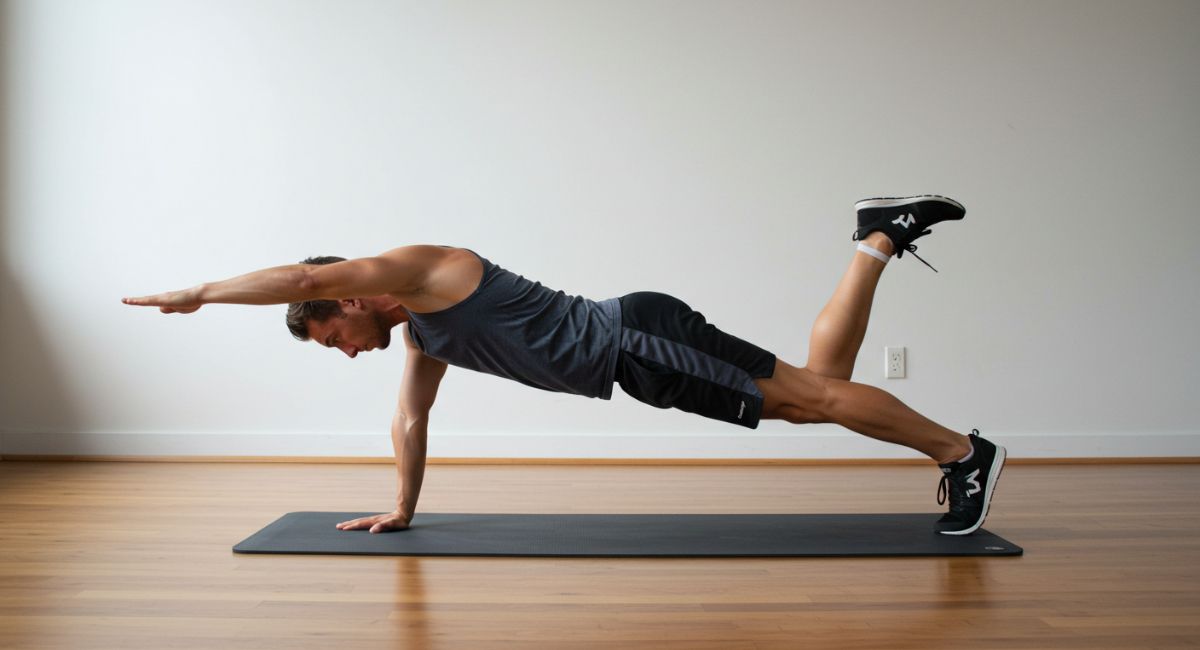Bird Dog Exercise: Benefits, Form & Variations
The bird dog exercise may not look flashy, yet it remains one of the most powerful movements you can add to your fitness routine. Since it is performed on all fours, this low-impact move strengthens the core stability muscles, enhances balance, and improves posture without the need for equipment. In fact, physical therapists often recommend it for injury recovery and back pain prevention, while athletes rely on it to boost functional performance.
What truly makes the bird dog unique is its ability to activate multiple muscle groups at once, from the spine-supporting stabilizers to the glutes and shoulders. Therefore, by practicing it regularly, you not only build strength but also protect your body from everyday strain. Whether you’re a beginner or advanced, this simple yet effective move deserves a permanent place in your workout routine.
What Is the Bird Dog Exercise?
The bird dog exercise is a core-strengthening move performed on all fours. While extending one arm and the opposite leg, you must keep the spine stable, which immediately engages multiple muscle groups.
It is classified as an anti-rotation core exercise. In other words, it trains your trunk to resist twisting, and as a result, it helps you develop stability and balance. Although the movement looks simple, it requires focus, coordination, and proper form to unlock its full benefits.
Why the Bird Dog Exercise Matters
Unlike many traditional ab workouts that only target surface-level muscles, this exercise strengthens the deep stabilizers of the spine and pelvis. Consequently, it becomes especially useful for a variety of purposes:
-
Rehabilitation – Physical therapists frequently prescribe it to patients recovering from back injuries or surgeries.
-
Prevention – It helps protect against common issues like lower back pain and poor posture.
-
Performance – Athletes benefit from improved balance, coordination, and functional strength.
-
Everyday Life – Stronger core muscles mean easier movements in daily tasks such as bending, lifting, or carrying.
Muscles Worked During Bird Dog Exercise
One of the biggest advantages of the bird dog exercise is its ability to engage multiple muscle groups simultaneously. For example:
-
Core muscles: Transverse abdominis, rectus abdominis, obliques
-
Back muscles: Erector spinae, multifidus
-
Glutes: Gluteus maximus and gluteus medius
-
Shoulders: Deltoids, rotator cuff muscles
-
Hips: Hip flexors and stabilizers
Because this network of muscles works together, the bird dog builds a solid foundation for both movement and stability.
How to Perform the Bird Dog Exercise Correctly
Mastering the bird dog exercise requires proper technique. Therefore, follow these steps carefully:
-
Start position:
-
Begin on all fours with hands under shoulders and knees under hips.
-
Keep your spine neutral and your gaze toward the floor.
-
-
Engage the core:
-
Draw your belly button gently toward your spine.
-
Avoid arching or rounding your back.
-
-
Extend opposite limbs:
-
Slowly lift and extend your right arm forward and your left leg back.
-
Keep them parallel to the floor.
-
-
Hold position:
-
Pause for 3–5 seconds while maintaining balance.
-
Meanwhile, focus on steady breathing.
-
-
Return and repeat:
-
Bring your arm and leg back down.
-
Then switch sides and continue alternating.
-
💡 Tip: Quality is always more important than speed. Hence, move slowly and with control to maximize results.
Benefits of the Bird Dog Exercise
1. Builds Core Stability
Because it challenges your body to stay balanced, this exercise strengthens deep stabilizers that traditional crunches often miss.
2. Improves Posture
By targeting the spine-supporting muscles, it reduces slouching and, as a result, promotes upright posture.
3. Reduces Back Pain
The exercise is frequently used in rehabilitation programs since it strengthens the lower back without adding strain.
4. Enhances Coordination
Extending opposite limbs requires cross-body coordination, which in turn sharpens motor control.
5. Functional Strength for Daily Life
From lifting groceries to playing sports, the improved balance and core stability easily transfer to real-world activities.
Common Mistakes to Avoid
Even though the bird dog exercise looks simple, mistakes can quickly reduce its effectiveness. Therefore, watch out for:
-
Arching the lower back – Keep your spine neutral.
-
Tilting the hips – Hips should stay square to the floor.
-
Rushing the movement – Slow and controlled reps always work best.
-
Not engaging the core – Remember to brace your abdominal muscles.
-
Overextending limbs – Lift only to shoulder and hip height.
Bird Dog Exercise Variations
Once you master the standard version, you can challenge yourself with these variations:
-
Bird Dog Crunch – After extending, bring elbow and knee together under your body before extending again.
-
Bird Dog Hold – Hold the extended position longer (10–15 seconds) to increase time under tension.
-
Weighted Bird Dog – Add a small ankle weight or wrist weight for extra resistance.
-
Resistance Band Bird Dog – Loop a band around your foot and opposite hand for added challenge.
-
Bird Dog Plank – Perform the move from a plank position to intensify core activation.
Who Should Do the Bird Dog Exercise?
This is suitable for nearly everyone, including:
-
Beginners looking for a safe core workout
-
People with lower back discomfort (with doctor or therapist approval)
-
Athletes aiming to improve stability and performance
-
Office workers combating poor posture
-
Older adults seeking balance and fall prevention
Since it’s both low-impact and adaptable, it works well across all fitness levels.
How to Add Bird Dog Exercise to Your Routine
For best results, include the bird dog exercise in your warm-up, mobility training, or core workout.
-
Beginners: 2–3 sets of 8–10 reps per side
-
Intermediate: 3–4 sets of 12–15 reps per side
-
Advanced: 3–4 sets of 10 reps with holds or variations
Additionally, pair it with other core-strengthening exercises like planks, glute bridges, and dead bugs for a balanced routine.
FAQs About the Bird Dog Exercise
1. Is the bird dog exercise good for beginners?
Yes. It’s beginner-friendly, requires no equipment, and can be easily modified to suit different fitness levels.
2. How often should I do the bird dog exercise?
You can perform it 3–4 times per week as part of your regular workout or rehabilitation plan.
3. Does the bird dog exercise help with back pain?
Absolutely. It strengthens the core and spine-supporting muscles, which often reduces discomfort when performed correctly.
4. Can I do the bird dog exercise every day?
Yes, since it’s low-impact. However, always listen to your body and avoid over training.
5. What if I struggle with balance during the bird dog exercise?
Start with smaller ranges of motion or keep your hand and foot closer to the floor until you gain more stability.
Final Thoughts
This exercise is more than just a simple move—it’s a powerful tool for building strength, improving balance, and preventing injury. Moreover, by practicing it with proper form and consistency, you’ll notice improvements not only in your workouts but also in everyday life.
Whether you’re a fitness enthusiast, an athlete, or someone looking to protect your spine and posture, the bird dog deserves a place in your routine. So add it today, and watch your stability, strength, and confidence soar.



